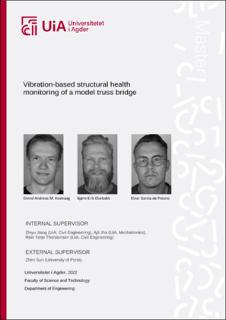| dc.description.abstract | Vibration-based methods with accerleration sensors are playing an increasingly important role in structuctural health monitoring of modern bridges. This master thesis investigates how the change in the truss bridge’s dynamic response when altering the physical properties. The study will be carried out experimentally by performing analytical and experimental modal analyses. The analyses will cover three cases involving the truss model bridge. These will cover one intact case and two different damage cases where the physical properties of the bridge is altered. First, we created numerical model of a truss bridge along with a model bridge of the same bridge design. Second, we run an analytical modal analyse of the numerical model. The analytical modal analysis consisted of two cases, the first case was the bridge undamaged, the second was the bridge with one diagonal member removed. Third, we conducted two different types of modal analyses on the physical model, where one was classical, and one was operational. The classical was only with the bridge undamaged and done with low sensitivity sensors. The operational was done with high sensitivity sensors and consisted of three different cases. The first case was the bridge undamaged, the second was the bridge with one diagonal member removed, and the third was the bridge with one diagonal member loosened. Finally, we compared the different modal analyses to each other. The main finding is that both damage case 1 where the truss element is removed and damage case 2 where the element was loosened showed on average -6.49% and -8.37% decrease in the eigenfrequencies in the z-direction. The damage cases were applied on the element contributing to vertical stiffness, this was reflected in the result as the damage affected the vertical modes about 5x and 7.5x more than the lateral modes in damage case 1 and 2. The analytical modal analysis (AMA) result had discrepancies of 0-10% to the experimental modal analyses (CMA and OMA) in the undamaged case. The damage simulation in the AMA gave a significantly larger decrease of -9.83% in the lateral modes compared to the OMA which had only -0.87%. The thesis show that structural health monitoring based on vibration measurements can be achieved by instrumenting the bridge with accelerometers in key locations. By doing this we are able to measure the free vibrations of the bridge’s superstructure. The raw vibration data from the measurements can then be decomposed to identify the bridge’s mode frequencies. The mode frequencies are dependent on the bridge’s structural stiffness and weight. Knowing this, any change in the eigenfrequencies can be treated as a change in stiffness of the superstructure. This may be caused by structural damage and should be investigated. | |
